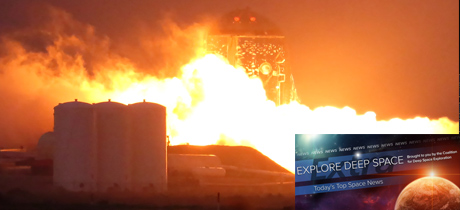In Today’s Deep Space Extra… U.S. National Space Policy due a Trump administration update. White House to reach out for discussion with potential international partners on mining resources found on the Moon and other planetary bodies.
Human Space Exploration
Space Council to update 2010 National Space Policy
Spacepolicyonline.com (5/6): U.S. National Space Policy is slated for an update, its first since the Obama Administration in 2010, Scott Pace, executive secretary to the White House National Space Council, explained in a podcast, whose sponsors included the American Institute for Aeronautics and Astronautics (AIAA) and Space Foundation. The 2010 version erased previous plans by President George W. Bush to mount a return to the Moon with human explorers, a plan re-embraced by the Trump administration, which now includes an emphasis on finding and using lunar resources, according to an executive order issued in April. Meanwhile, Dmitry Rogozin, the head of Roscosmos, the Russian space agency, has criticized any effort to circumvent the U.N. in order to establish a policy for exercising resource rights, comparing such a move to an invasion of Iraq or Afghanistan.
Bridenstine ties international cooperation on Artemis to norms of behavior in space
SpaceNews.com (5/6): Speaking earlier this week at a Center for Strategic and International Studies (CSIS) webinar, NASA Administrator Jim Bridenstine suggested that efforts to obtain international cooperation in the agency’s Artemis initiative to return human explorers to the surface of the Moon in 2024 could serve as a means of extending influence and setting norms for behavior on the Earth as well as in space.
NASA outlines plans to gradually reopen centers
SpaceNews.com (5/6): Space agency leadership is finalizing a plan to re-open its chain of field centers once the peak of the COVID-19 pandemic has passed. However, the process could be slow and tailored to the environment at each of the facilities, with many employees teleworking for perhaps months to come. In order to accomplish a full retreat from COVID-19 avoidance measures, each center will have to back away from up to four work place phases, with the most restrictive allowing only those responsible for infrastructure and lives to work on site. An estimated 90 percent of workers are currently teleworking.
Space Science
What just happened to comet Swan?
Spaceweather.com (5/6): Another recently discovered comet, Swan, appears to be fragmenting as it nears the sun. Observers in the southern hemisphere could see the breakup without binoculars or telescopes. Swan will make its closest pass to Earth on May 12 and the sun on May 27. Swan was discovered April 11 by an amateur astronomer in Australia.
Astronomers say they’ve found the closest black hole to Earth
The Verge (5/6): A newly found black hole lurks just 1,000 light years from Earth, the closest discovery of its kind yet, While the black hole is not visible to naked eye observers, a pair of companion stars are, though visible in the night sky from the southern hemisphere. The black hole was discovered by astronomers observing at the European Southern Observatory in Chile.
Op Eds
Taking stock of NASA Commercial Lunar Payload Services progress
Coalition Member in the News – Astrobotic Technology
SpaceNews.com (5/6): In an op ed, John Thornton, CEO of Astrobotic Technology, explains how NASA’s Commercial Lunar Payload Services (CLPS) initiative is helping to recharge American leadership in space. Under the initiative, NASA lined up 14 U.S. companies to deliver science and technology payloads to the Moon. Astrobotic will be among the first to launch. “Each CLPS mission will launch a thousand new scientific questions and spur American scientific leadership into the 2020’s,” writes Thornton.
Rethinking what space activities are essential
Coalition Members in the News – Airbus, United Launch Alliance
SpaceNews.com (5/2): The U.S. space industry has been considered by the U.S. government an “essential industry,” managing to function in the face of workplace restrictions linked to the coronavirus pandemic. However, a careful selection of which operations and activities and necessary employees has been warranted.
Other News
X-37B spaceplane to carry DoD and NASA experiments in upcoming mission
Coalition Members in the News – Boeing, United Launch Alliance
SpaceNews.com (5/6): The next launch of the of the U.S. Air Force X-37B is planned for May 16 from Cape Canaveral Air Force Station, Florida, and will include for the first time a service module to host experiments. Two of those experiments are NASA’s to study the effects of radiation and other elements of the space environment of materials and seeds that could be used to grow food.
DoD says it was blindsided by FCC Ligado decision, will petition to have it reversed
SpaceNews.com (5/6): Pentagon officials appeared before the U.S. Senate Armed Services Committee this week to seek relief from a decision by the FCC to grant Ligado permission to establish a cellular network using bandwidth adjacent to that used by the GPS navigational network. The DoD is facing a deadline of May 29 to appeal the FCC’s decision and its implications for national security with the Commerce Department’s National Telecommunications and Information Administration.
SpaceX’s Starship SN4 prototype fires rocket engine for 1st time
Space.com (5/6): SpaceX’s latest Starship prototype, SN4, ignited a Raptor rocket engine for the first time during a ground test late Tuesday at launch operations facilities in South Texas. A brief uncrewed test flight is to follow, to an altitude of about 500 feet.

